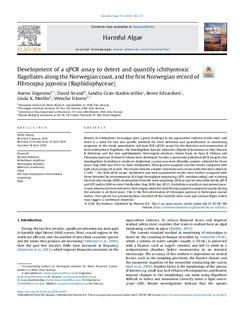| dc.contributor.author | Engesmo, Anette | |
| dc.contributor.author | Strand, David | |
| dc.contributor.author | Gran-Stadniczeñko, Sandra | |
| dc.contributor.author | Edvardsen, Bente | |
| dc.contributor.author | Medlin, Linda K. | |
| dc.contributor.author | Eikrem, Wenche | |
| dc.date.accessioned | 2019-01-04T13:36:05Z | |
| dc.date.available | 2019-01-04T13:36:05Z | |
| dc.date.created | 2018-07-10T11:01:46Z | |
| dc.date.issued | 2018 | |
| dc.identifier.citation | Harmful Algae. 2018, 75, 105-117. | nb_NO |
| dc.identifier.issn | 1568-9883 | |
| dc.identifier.uri | http://hdl.handle.net/11250/2579248 | |
| dc.description.abstract | Blooms of ichthyotoxic microalgae pose a great challenge to the aquaculture industry world-wide, and there is a need for fast and specific methods for their detection and quantification in monitoring programs. In this study, quantitative real-time PCR (qPCR) assays for the detection and enumeration of three ichthyotoxic flagellates: the dinoflagellate Karenia mikimotoi (Miyake & Kominami ex Oda) Hansen & Moestrup and the two raphidophytes Heterosigma akashiwo (Hada) Hada ex Hara & Chihara and Fibrocapsa japonica Toriumi & Takano were developed. Further, a previously published qPCR assay for the dinoflagellate Karlodinium veneficum (Ballantine) Larsen was used. Monthly samples collected for three years (Aug 2009–Jun 2012) in outer Oslofjorden, Norway were analysed, and the results compared with light microscopy cell counts. The results indicate a higher sensitivity and a lower detection limit (down to 1 cell L−1) for both qPCR assays. Qualitative and semi-quantitative results were further compared with those obtained by environmental 454 high throughput sequencing (HTS, metabarcoding) and scanning electron microscopy (SEM) examination from the same samplings. All four species were detected by qPCR and HTS and/or SEM in outer Oslofjorden (Aug 2009–Jun 2012); Karlodinium veneficum was present year-round, whereas Karenia mikimotoi, Heterosigma akashiwo and Fibrocapsa japonica appeared mainly during the autumn in all three years. This is the first observation of Fibrocapsa japonica in Norwegian coastal waters. This species has previously been recorded off the Swedish west coast and German Bight, which may suggest a northward dispersal. | nb_NO |
| dc.language.iso | eng | nb_NO |
| dc.publisher | Elsevier | nb_NO |
| dc.rights | Attribution-NonCommercial-NoDerivatives 4.0 Internasjonal | * |
| dc.rights.uri | http://creativecommons.org/licenses/by-nc-nd/4.0/deed.no | * |
| dc.title | Development of a qPCR assay to detect and quantify ichthyotoxic flagellates along the Norwegian coast, and the first Norwegian record of Fibrocapsa japonica (Raphidophyceae) | nb_NO |
| dc.type | Journal article | nb_NO |
| dc.type | Peer reviewed | nb_NO |
| dc.description.version | publishedVersion | nb_NO |
| dc.rights.holder | © 2018 The Authors. | nb_NO |
| dc.source.pagenumber | 105-117 | nb_NO |
| dc.source.volume | 75 | nb_NO |
| dc.source.journal | Harmful Algae | nb_NO |
| dc.identifier.doi | 10.1016/j.hal.2018.04.007 | |
| dc.identifier.cristin | 1596513 | |
| dc.relation.project | Norges forskningsråd: 196702 | nb_NO |
| cristin.unitcode | 7464,20,14,0 | |
| cristin.unitname | Marin biogeokjemi og oseanografi | |
| cristin.ispublished | true | |
| cristin.fulltext | original | |
| cristin.qualitycode | 1 | |

